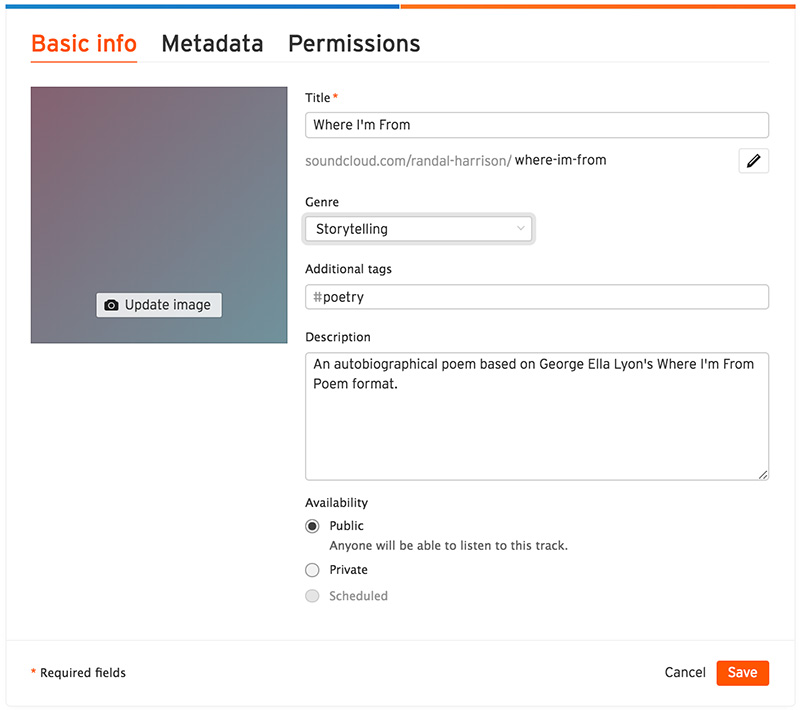‘Where I'm From’ Poem
Use audio to share an autobiographical poem.
The language and music of poetry can be found in everyone's life. In this project, you will write, record, and share an autobiographical poem using George Ella Lyon’s ‘Where I’m From’ poem as an example. This type of poem is built from an expressive list of people, places, things, and events that you feel best represent you as a unique person from a specific time, place, and cultural milieu. You'll record yourself reading the poem, add a music soundtrack, and share your work to the cloud.
Audacity- Poetry
- Sound editing
- Autobiography
Learning Goals
After you finish this activity you will be able to:
- Capture a high quality voice recording
- Locate music and/or sound effects for use in the recording
- Edit a sound recording
- Publish the sound recording to the cloud
Follow these steps to complete the project.
To track your progress, click each step as you finish.
An excellent first step in creating any media work is to examine exemplary works of the same type. Make a list for yourself of what makes these examples strong and inspiring.
Don't skip this step!
| 1 | Get inspired by visiting the links in the Get Inspired box. |
| 2 | Read or watch George Ella Lyon's ‘Where I'm From’ poem. |
By growing your skills in the tools used in any project, you save yourself time and produce stronger work.
| 3 | Peruse any or all of the tutorials in the Tame Your Tools box. |
When beginning a new media project, it's best to organize your resources in a single location.
| 4 | Create a folder on your Desktop named something memorable, such as my-media-project. In this folder you'll organize all your resources for this project. |
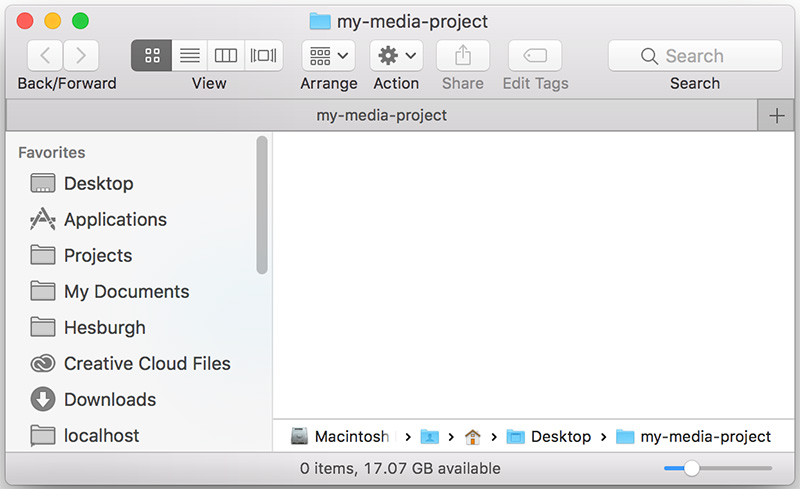
Alternate File Storage
You may also organize
your documents in cloud storage, such as Box or Google Drive.
To write this type of autobiographical poem, you'll need to make a list of memorable influences.
| 5 | Let's brainstorm! Use the list creator below to make a list of your own specific examples for any of the poem elements below—or any others you can imagine! |
- An Ethnic or cultural identity
- An item(s) your prized as a child
- Influential writers/thinkers
- A specific smell or sound or sight
- A singer who inspired you
- Challenges you rose to
- Heroes you revered
- A family trait or tradition
- A place you congregated
- Moments that changed you
- Community landmarks
- Historical moments you lived
- The description of your town
- A trait defining only you
Need a little more help?
This Poetry Mad Lib may help you generate a rough structure for your poem.
In this step, you'll turn the lines you wrote in your brainstorming work into a real poem.
| 6 | Once you have a list of poem elements, edit and order them to make a poem using a word processor such as Microsoft Word or Google Docs. |
| 7 | As you edit the poem, practice reading it aloud, occasionally. Revise the poem until you're satisfied. |
| 8 | Save a copy of the polished written poem to your project folder. |
At this point, you must decide on how and where to record yourself reading your poem.
| 9 | Choose a recording method/equipment. |
The Hesburgh Libraries offers a sound-dampening Sound Booth with fabric walls in which you can record high-quality audio using your own laptop. For the best audio, we recommend you borrow a USB microphone.
Bookings do not include assistance with using the studio. For assistance, contact the Media Corps.
Faculty, staff and students may reserve Tascam audio recorders. Equipment used for class assignments may often be reserved for free for brief periods. For more information or to borrow a Tascam recorder visit the OIT.
DeBartolo 115
(574) 631-6423
eventrentals@nd.edu
For instructions on using a Tascam to record audio, see Tame Your Tools.
You may record yourself with your own computer or mobile devices. Audacity is a free, cross-platform application for recording and editing sound on a computer. There are also many apps available for recording your voice on a mobile device. One strong option is VoiceRecord Pro:
- VoiceRecord Pro (iOS)
- VoiceRecord Pro (Android)
For instructions on using VoiceRecord Pro to record audio, see Tame Your Tools.
| 10 | Record yourself reading your poem. Make sure to introduce yourself each time with the line "Where I'm From, by [your full name]." Do several takes. Save the best take as an MP3 file in your project folder. |
Having written your poem, choose a soundtrack to layer behind your reading of the poem. Make sure to choose music that matches the theme and tone of your poem.
| 11 | Visit the YouTube Audio Library. |
| 12 | Select the Free Music tab. |

| 13 | Search and filter for music by any combination of Genre, Mood, Instrument, or Duration. |
| 14 | Choose an Attribution option. We recommend "Attribution not
required." |

Giving Proper Attribution
If you choose the
"Attribution required" option, you must credit
the composer of any music you use in your project.
| 15 | Click the download icon to download the track (MP3) you choose. Save this soundtrack file to your project folder. |
Now, you'll create an audacity project for layering together all the audio you've found and created.
| 16 | Launch Audacity on the computer you are working on. If you are working on your own computer, you will want to download Audacity if you have not already done so. |
| 17 |
Save your Audacity project file (.aup) in your my-media-project folder. Audacity will also add a resources folder called where-from-audacity-project_data, which you may safely ignore. Your project folder should now contain:
|

Next, we'll import your voice recording and your soundtrack into your new Audacity project.
| 18 | With Audacity open, select to import the MP3 of you reading your poem. |
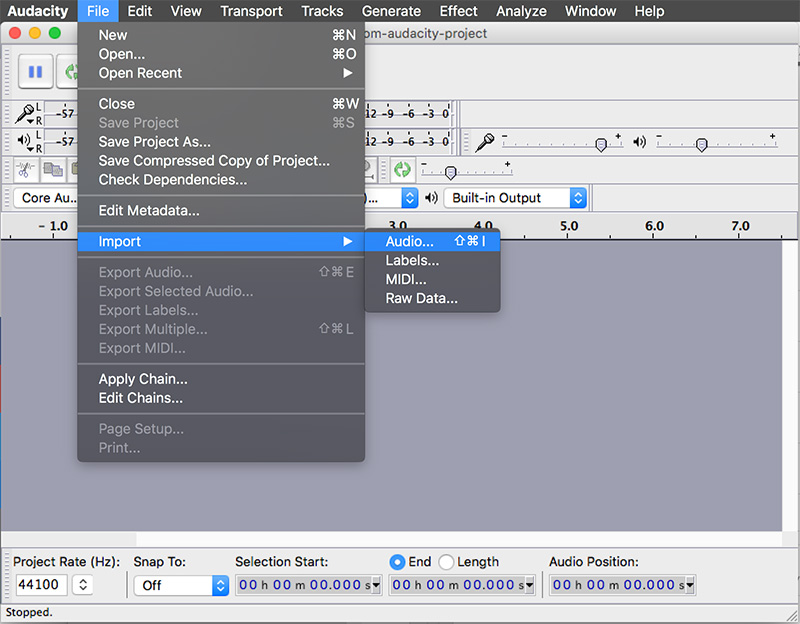
| 19 | Repeat step 18 to import the MP3 of your soundtrack. When you are finished, your project window should show these tracks stacked on top of each other. |
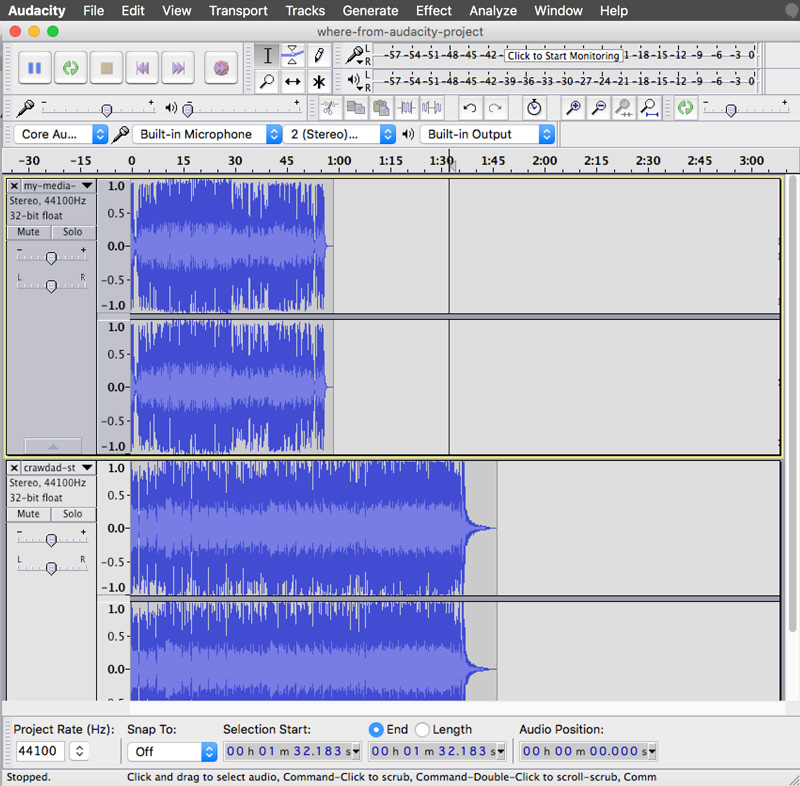
In this step, you will edit each of your tracks, layering and syncing them so that they sound like one polished audio track, beginning to end. Remember that the volume level of the soundtrack should be low enough that it underscores your reading of the poem rather than dominating it.
| 20 | If you haven't already done so, watch How To Record and Edit Audio In Audacity. |
| 21 | You may use the selection tool () to cut unwanted parts from your audio track, and cut-and-paste audio within and between tracks. |
| 22 | You may use the time slider tool () to sync tracks, shifting each track forward or back in relation to each other. |
| 23 | Finally, select the audio you wish to fade out and select from the application menu. Feel free to experiment, applying various effects and filters to your audio which seem appropriate. |
| 24 | Make sure to save regularly as you edit your project file (.aup). |
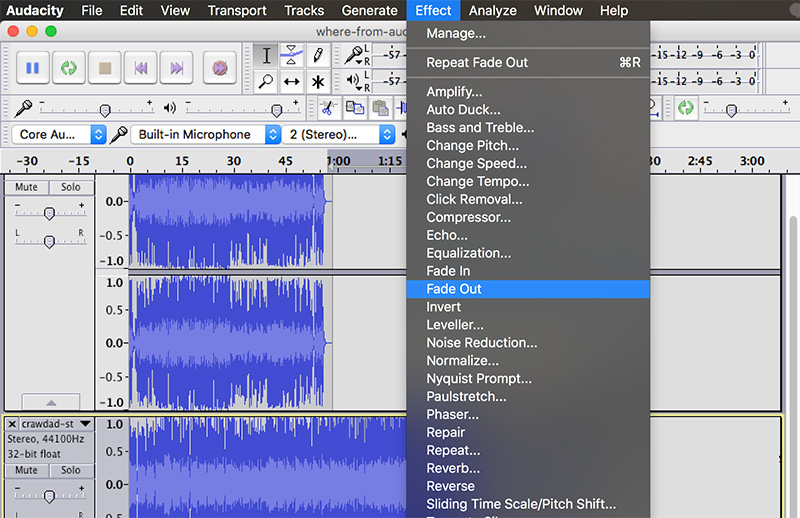
Now, you'll need to export your poem to a format which can be shared on the web, such as MP3.
| 25 | Select from the application menu to export your project to an MP3 file. |

| 26 | Navigate to your project folder to save your polished poem file as an MP3. Name the file "final-poem-mp3" (or anything memorable which will distinguish it from the rough audio files you used to make it). Select and choose 'MP3 Files'. |
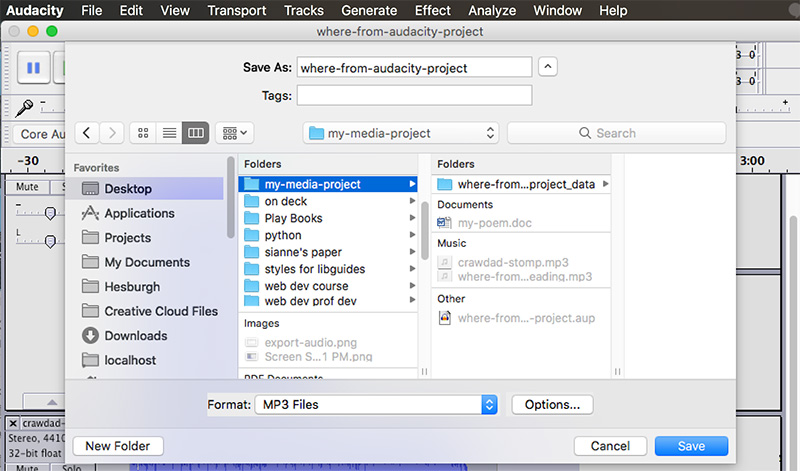
| 27 | Select the button to open the window, where you'll set the Bit Rate Mode to 'Constant', the Quality to '320 kbps', and Channel Mode to 'Joint Stereo'. |
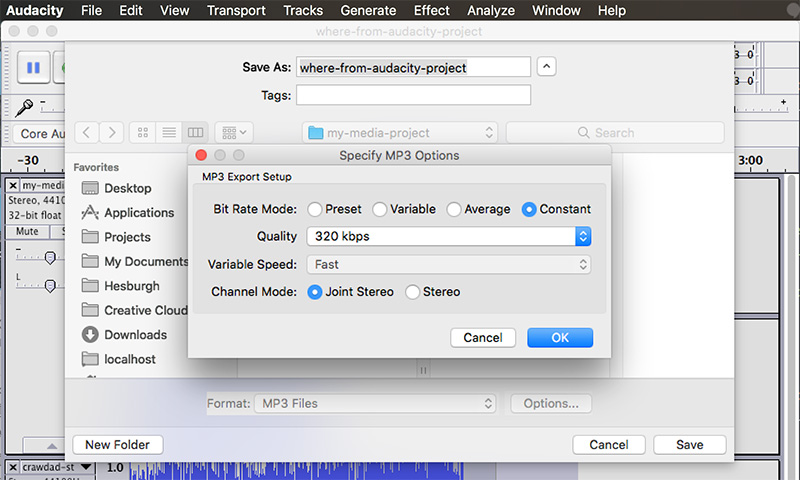
| 28 | Click to close the window. Then click the button to export your MP3. |
| 29 | The last step before saving asks you to provide metadata in the window. This step is optional, but recommended. Click to continue. |
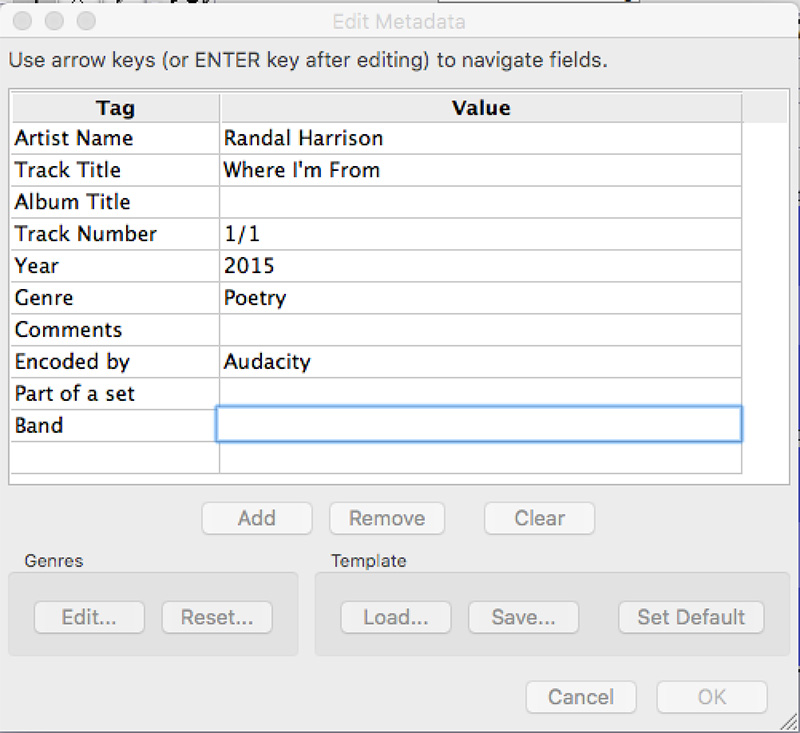
In this last step, you'll upload your audio poem to Soundcloud, to share with others.
| 30 | Login to Soundcloud, a cloud-based platform for sharing audio. You may create your own account or sign in using your Notre Dame Google Account. |
| 31 | Select from the application menu. Click the button and navigate to your project folder. Select your finished project MP3 and click . |

| 32 | Add information as desired in the Basic Info, Metadata, and Permissions window and click . Remember to set the project to Public in order for others to find and listen to it online. |
| 33 | Your "Where I'm From" poem is now live and public in the cloud. Copy the link to email or share your link on social media! |
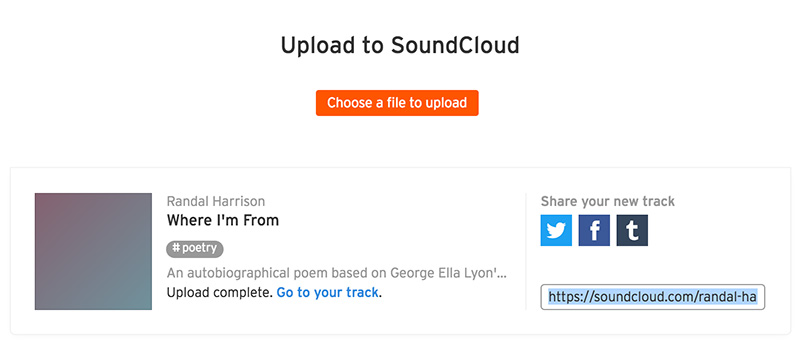
Congratulations!
You've grown your multimedia literacy while creating cool things! Well done, you!
You might consider nominating work you are proud of to the Remix Project Showcase!
Example

Get Inspired
Explore examples of similar projects.
Tame Your Tools
Get Help
Notre Dame has many helpful resources, including our Media Corps coaching staff, located in the Hesburgh Library.
Give Feedback
Remix is continually evolving. Please help us improve by providing feedback on this project or any other feature of Remix.
